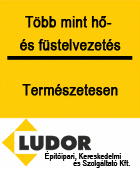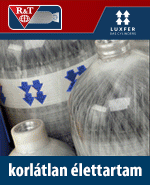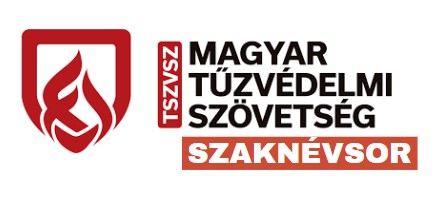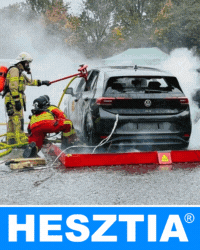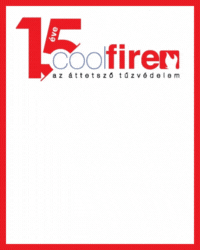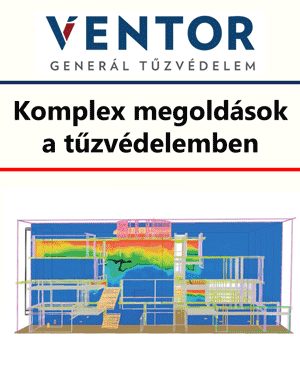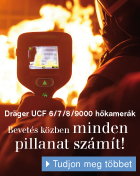|
Híreink Szakmai linkek Szaknévsor |
ISCFEDM – Section B, Fire Protection0000. 00 00. 10:05 This page contains the presentations of Section B of the International Scientific Conference on Fire Engineering and Disaster Management 2021. (Az oldal a Tűzvédelmi Mérnöki és Katasztrófavédelmi Nemzetközi Tudományos Konferencia angol nyelvű előadásainak anyagait tartalmazza.) Table of contents for this section(Click the links below to jump to the desired presentation. Be advised: page load may be slow due to the embedded YouTube-videos. Please allow up to 1-2 minutes for the whole page to load.)
Subsection 1 Szalai, M.: Danger of dust explosion and importance of testing for explosive dusts Hlavicka, V: Cracks in normal strength concrete and mortar subjected to elevated temperatures
Subsection 2 Raffai-Horváth Examination of the transport of high consequence flammable dangerous goods
Subsection 3 Péter Tóth, Péter Pántya: The role of ÉMI LLC. in Hungarian fire protection Rhoda Mensah:Advances in Assessment Methods for Fire Safety Peter Pantya: Issues of energy sources in the field of Fire Protection
Subsection 4 Peter Pantya: Basics of the fire protection of alternative energy sources Király, L. Restás, Á.: Examination of ATEX rule changes in Hungary
Subsection 5 S. Ramakrishna, O. Das, A. Restas: Microscale Combustion Calorimetry (MCC) L. Bérczi, D. Farkas: Research on the development of the fire investigation procedures Mészáros, I-Kátai-Urbán, L-Cimer, Zs-Gy. Vass: Hospital evacuation Subsection 1Tóth-Pataki, Zs., Szép, J., Kerekes, Zs., Restás, Á.: Role of radiation heat in the thermodynamic classification of polystyrene thermal insulatorsAbstract: The coating of buildings and facilities with insulating material is of paramount importance in connection with energy efficiency. Insulation is manufactured differently depending on the type, but they are certified according to a uniform standard. In the present dissertation, we examine the three most common “white” EPS, XS and graphite materials, whether the so-called EUROCLASS EN 11 925 so-called small flame test. Furthermore, do the effects of cutting surfaces in practical use on fire protection show a difference between “factory cut” surfaces and “home cut”. The small flame test showed that since there is no flame combustion, so the flame propagation does not give a meaningful qualification among the EPS samples. Therefore, further tests should be continued with radiant heat. On the other hand, the radiant heat reaches the material over a larger area, so that an early effect of the fire can be better modeled. Burning of the materials is always preceded by the preliminary heat load, with significant damage, which already makes a significant difference between the individual samples. This is because the deformation increases at a very faster rate than the burnout itself.
Zsuzsanna Kerekes was born 1958 in Budapest. She began her hight studies in 1976 at the Pannon University in Veszprém, and obtained the MSc degree in chemical engineering, silicate chemistry specialization. She began her dr.univ studies in 1981 at the Doctoral School of Budapest University of Technology Faculty of Chemical Technology and Biotechnology. She has been an university lecturer since 1999-2020 at Ybl Miklós Faculty of Architecture and Civil Engineering Fire-safety Engineering Óbuda University as fire protection laboratory leader. She obtained a PhD degree in 2015 and habil degree in 2019. Instructor since 2019 at the University of Public Service. She has been working in her profession for 40 years in various fields: material structure research, ceramics, glass, analytics. Her research topic is “research and development combustion mechanism of non-combustible and combustible materials,”
Szalai, M.: Danger of dust explosion and importance of testing for explosive dustsAbstract: When assessing dust explosion risks in industrial environments, one challenging and poorly understood question is “what should we test”? For liquids and gases, flammability data (at least under atmospheric pressure and normal temperature conditions) are well understood and available in the open literature for most common liquids and gases. Such data for dusts is more limited because of the major impact of particle size, moisture content and even particle morphology. The complexity is compounded often as many products are made up of a number of components, so that there is a virtually unlimited number of “materials” in existence with properties different from the individual components. Even worse is the situation that those secondary components are not always obvious in the name. The main hazard characteristics of powders associated with dust explosion can be categorised as ignition sensitivity, explosion severity, flammable limits and electrostatic properties . Main hazard characteristics of combustible dusts
The main hazard characteristics of combustible dusts can be determined by laboratory tests. This presentation provides some insight into what tests need to be performed to design the appropriate equipment for an explosive hazard for a given explosive technology, to select appropriate explosion-proof equipment, and to identify explosive zones in accordance with the ATEX Directives.
Monika Szalai was graduated as chemical engineering MSc in 1997 from the Faculty of Chemical Engineering of Budapest University of Technology. In 2014, she graduated as a fire protection engineer. In 2017, she graduated as an occupational safety engineer. Areas of work: chemical technology design, explosion protection, she is an explosion protection specialist Hlavicka, V: Cracks in normal strength concrete and mortar subjected to elevated temperaturesAbstract: Being exposed to high temperatures (fire), various chemical and physical changes happen in concrete, resulting in the loss of load-bearing capacity. Several researchers investigated changes in the compressive strength, tensile strength and modulus of elasticity of different types of concrete exposed to high temperature. On the other hand, only a few papers focused on the cracks and the crack propagation in thermally damaged concrete. The main goals of the presented research are examination of the properties of cracks and crack propagation in thermally damaged concrete and provision of parameters for finite element and other calculations. Keywords: concrete, fire, fracture, fracture energy, CMOD
Makovická Osvaldová, L.: Determination of selected fuel values of wood in case of forest fire in an area of natural disasterAbstract: Forest fires are quite a common phenomenon, even on the European continent. Even if this phenomenon was quite rare in our territory in the past, it needs to be given close attention in the future. Fire-fighting requires great manpower and resources, in many cases on a long-term scale. The equipment, machinery and tactics of intervention units specializing in forest fire-fighting are always changing. Forest fire-fighting has become the subject of much research, and predictive scenarios for forest fire development are designed and tested. The latest equipment, geographic information systems (GIS), knowledge of geomorphological and climate conditions, and meteorological conditions are all included in fire simulations. An important factor for such a simulation is knowing what kind of fuel naturally occurs in the area of the potential forest fire. This article aims to compare methods of testing the fire characteristics and differences in fuel properties according to the position of the wood on the tree (branch, trunk and root) for various coniferous tree species (spruce, fir, pine and larch). To determine these characteristics, the test method, in particular the dimensions of the samples, had to be modified. The results of the experiments are presented in this article in the form of charts. Key words: forest fire, coniferous tree species, weight loss, burning rate.
Subsection 2Raffai-Horváth Examination of the transport of high consequence flammable dangerous goodsAbstract: The purpose of the poster was to give a short professional presentation of the transport of high consequence flammable dangerous goods. Being aware of public safety planning and dangerous goods with a high risk to public security is not only important for those who work with dangerous goods on a daily basis, but it is also an essential topic for those who live near facilities with such activities, routes or rest areas. In order to protect the inhabitants’ lives and the environment, the prevention of accidents during the shipping of dangerous goods is necessary, together with the quick and professional elimination of a possible occurrence. One of the goods with a high risk to public safety is flammable and explosive substances, which pose a serious threat to human life and the environment, because where there is a substance with this property, there is a constant risk of fire. Companies and plants engaged in the transport and storage of dangerous goods must prepare a safety plan in order to maintain public safety.
She was born on 17 of April 1988 in Szekszárd. She began her studies in 2006 at the Miklós Zrínyi National Defence University obtained the BSc degree in defence administration as a defence administration officer and in 2009 the MSc degree in defence administration as a defence administration manager, disaster specialization. She began her PhD studies in 2013 at the Doctoral School of Military Engineering at the University of Public Service. Her research topic is emergency planning at railway marshalling yards, and dangerous goods transportation. She is also has a certificate of training as safety adviser for the transport of dangerous goods by road, rail and inland waterway. In addition she is the secretary at Scientific Students Association at the Faculty of Law Enforcement at UPS. She received the excellent lecturer title of the Institute in 2017.
Ragács, N., Kerekes, Zs., Szép, J.,Restás, Á.: Effect of Thermodynamic Behavior of Isolation Materials on smoke generationAbstract: In our work, we investigated the thermodynamic nature of three insulating materials as a function of temperature and time. The thermoanalytical analysis is performed by thermogravimetry, differential thermal analysis, and mass spectrometry with evolving gas analysis [1]. The aim of the test is to determine the change in a selected material before the appearance of flame. In thermal analysis, the study of the change in mass and enthalpy of selected samples as a function of temperature and during the heating of materials over a time interval and the evolution of gases. The results of thermoanalytical studies show in advance how a material can behave, what changes take place as under fire. The decomposition process and temperature provide information on the appearance of the expected toxic gases. There is a relationship between smoke generating ability and thermodynamic properties, they still contain combustible material.
Zsuzsanna Kerekes was born 1958 in Budapest. She began her hight studies in 1976 at the Pannon University in Veszprém, and obtained the MSc degree in chemical engineering, silicate chemistry specialization. She began her dr.univ studies in 1981 at the Doctoral School of Budapest University of Technology Faculty of Chemical Technology and Biotechnology. She has been an university lecturer since 1999-2020 at Ybl Miklós Faculty of Architecture and Civil Engineering Fire-safety Engineering Óbuda University as fire protection laboratory leader. She obtained a PhD degree in 2015 and habil degree in 2019. Instructor since 2019 at the University of Public Service. She has been working in her profession for 40 years in various fields: material structure research, ceramics, glass, analytics. Her research topic is “research and development combustion mechanism of non-combustible and combustible materials,”
Gyapjas, J., Bérczi, L.: Heat and smoke extraction from the point of view of the fire protection authority, in terms of with obtaining occupancy permitAbstract: Ensuring proper heat and smoke extraction is very important in fire protection. Its significance is also emphasized by earlier fire events. According to our hypothesis, the prevalence of certain sub-areas of heat and smoke extraction is not optimal. Construction is such a sub-area, therefore in our study we mainly deal with implementation. This can be improved by identifying connection network, methods, typical and recurrent insufficiencies, and making targeted suggestions. Relevant on-site experience is gained by the fire prevention authority, therefore this perspective was chosen in our study. We consider the construction of heat and smoke to be problematic, so greater emphasis is put on occupancy permit inspections. Our research methods were focus group interviews, questionnaires, and the analysis of documentation and regulation. Nodes were identified and a model of occupancy permit inspections was set up. The general situation assessment gradually declines from design through construction to operation. The safety awareness of investors and operators is considered to be low, and the problems experienced during construction and operation are considered to be relatively common. We identified 8 typical problems in the design phase and 10 in the construction phase. We present a complex solution plan. Based on the results, we recommend continuing the research, using it for educational purposes, and for the reviewing of regulations.
Komlai, K., Restás. Á., Kerekes, Zs.: Fire Resistance Termodinamic Test of Self-supporting Double Skin Metal Faced Sandwich Panels
Zsuzsanna Kerekes was born 1958 in Budapest. She began her hight studies in 1976 at the Pannon University in Veszprém, and obtained the MSc degree in chemical engineering, silicate chemistry specialization. She began her dr.univ studies in 1981 at the Doctoral School of Budapest University of Technology Faculty of Chemical Technology and Biotechnology. She has been an university lecturer since 1999-2020 at Ybl Miklós Faculty of Architecture and Civil Engineering Fire-safety Engineering Óbuda University as fire protection laboratory leader. She obtained a PhD degree in 2015 and habil degree in 2019. Instructor since 2019 at the University of Public Service. She has been working in her profession for 40 years in various fields: material structure research, ceramics, glass, analytics. Her research topic is “research and development combustion mechanism of non-combustible and combustible materials,” Krisztina Komlai was born on 14 February 1989 in Pécs. She began her studies in 2007 at the Budapest University of Technology and Economics Faculty of Chemical Technology and Biotechnology and obtained the BSc degree in Chemical Engineering. She began her MSc studies in 2013 at the University of Pannonia and obtained the MSc degree in Materials Engineering. She is currently a testing engineer at the Fire Testing Laboratory of ÉMI Non-profit Limited Liability Company for quality control and innovation in building. She is currently studying as Fire Safety Engineer and her research topic is “Fire resistance test of self-supporting double skin metal faced sandwich panels”. The expected time for her thesis defence is spring 2021. Subsection 3Debreceni, P: Review of National Forest Fire Prevention System In Hungary Innovative Strategies for Fire PreventionAbstract: The forest fire prevention activity is implemented in cooperation with the forestry authority and disaster management. Data collection and analysis of wildfires carried out, periods of high fire risk are determined and a fire ban is announced within the framework of the Forest Fire Information System. Based on the fire hazard classification of forest areas, forest fire protection plans are prepared and updated by authorities and forest managers. Providing appropriate information on forest fire for citizens is a core element of forest fire prevention. A communication plan has been prepared to organize communication actions and awareness raising campaigns. In this short study I would like to outline the structure of the forest fire prevention system in Hungary and to identify that topics where development and the incorporation of innovative techniques are needed.
Péter Tóth, Péter Pántya: The role of ÉMI LLC. in Hungarian fire protectionAbstract: The diverse activities of ÉMI Nonprofit LLC. are related to the Hungarian Disaster Management in many respects, especially to the field of fire protection. ÉMI Nonprofit LLC. is currently the largest organization in Hungary dealing with the conformity assessment and testing of construction products. The test reports, technical assessments, certificates and specialist resolutions issued by it are the accepted basic documents of fire protection planning. ÉMI also contributes to the preparation of Hungarian fire protection technical guidelines and fire protection legislation and standards. It shares its international experience in publications.
Rhoda Mensah:Advances in Assessment Methods for Fire SafetyPeter Pantya: Issues of energy sources in the field of Fire ProtectionAbstract: The built environment gives a frame to our life at home and during our working hours, travelling between them. In this circumstances multiple dangers are present to the people, some are by the built area and some by the standalone energy sources or the energy network. The fire protection has two brotherly sides. One is the prevention line, for example by the authority work (licensing, control) and the other line is the intervention, for the firefighting and technical rescues. In this presentation analysed some challenges and issues for the Fire Protection organisations in built environment and demonstrating some solutions to help the fire officers during the prevention and intervention duty close different energy sources.
Subsection 4Peter Pantya: Basics of the fire protection of alternative energy sourcesAbstract: We make our lives easier with various technical possibilities and machines. They are traditionally powered by electricity from transmission lines or by conventional diesel and petrol fuels. The different energy sources also pose tasks and challenges in the field of fire protection. A review of the basic, related knowledge is now done to see what these alternative directions are and what their characteristics are. What additional issues do each non-traditional energy source raise in the field of fire safety.
Király, L. Restás, Á.: Examination of ATEX rule changes in HungaryAbstract: today, there are a number of legal requirements in the field of the protection of explosion. Of these requirements, a significant is the 99/92/EC (also known as 'ATEX 137' or the 'ATEX Workplace Directive') on minimum requirements for improving the health and safety protection of workers potentially at risk from explosive atmospheres. The text of the Directive and the supporting EU produced guidelines are available on the EU-website. Directive 94/9/EC (also known as 'ATEX 95' or 'the ATEX Equipment Directive') on the approximation of the laws of Members States concerning equipment and protective systems intended for use in potentially explosive atmospheres. The text of the Directive and EU produced supporting guidelines are available on the EU website. Lajos Kiraly was born on 22nd of April in Tatabanya. He began his studies in 2004 at the University of Szechenyi Istvan, Gyor and graduated as an environmental engineer and in 2014 the BSc degree in mechatronics engineer in Banki Donat Faculty of Obuda University. He began his PhD studies in 2016 at the Doctoral School of Military Engineering at the University of Public Service. He is currently an EHS task owner in a multinational chemical industry, who works in the automotive industry and has market lead worldwide. His research topic is “research developements in ATEX.” The expected time for his thesis defence is spring 2021.
Ragács, N-Kerekes, Zs-Restás, Á: Thermodynamic behavior of isolation materials exposed to radiation heat
Zsuzsanna Kerekes was born 1958 in Budapest. She began her hight studies in 1976 at the Pannon University in Veszprém, and obtained the MSc degree in chemical engineering, silicate chemistry specialization. She began her dr.univ studies in 1981 at the Doctoral School of Budapest University of Technology Faculty of Chemical Technology and Biotechnology. She has been an university lecturer since 1999-2020 at Ybl Miklós Faculty of Architecture and Civil Engineering Fire-safety Engineering Óbuda University as fire protection laboratory leader. She obtained a PhD degree in 2015 and habil degree in 2019. Instructor since 2019 at the University of Public Service. She has been working in her profession for 40 years in various fields: material structure research, ceramics, glass, analytics. Her research topic is “research and development combustion mechanism of non-combustible and combustible materials,” Abstract: The system of tasks of the professional disaster management body comprises a very wide range of activities. The tasks based on industrial security, fire protection and civil protection include authority prevention of disasters, organization and management of protection, implementation of rescue in emerged civil emergencies, as well as liquidation of the harmful consequences and realization of restoration-reconstruction. In addition the industrial security, the professional field of water affairs and water protection have been performing more widely authority and professional authority activities in the past periods. Authority activity is the important part of disaster management, prevention, planning and organization activity. The fire protection authority takes licencing, prohibiting and limiting measures, conducts fire inspections, issues authority certificates and imposes fire protection fines during its activity. Key words: disaster management, fire protection, authority and professional authority activity, prevention
Subsection 5S. Ramakrishna, O. Das, A. Restas: Microscale Combustion Calorimetry (MCC)
L. Bérczi, D. Farkas: Research on the development of the fire investigation proceduresAbstract: In research on the development of fire investigation procedures we examined the corner stones; the personal conditions, the material conditions, the international results, the professional competitions and the achievements. These development possibilities were evaluated separately. Firstly the current situation and then the direction and schedule of development were presented. In the last 8 years the results has become tangible, the evidence of which is the effectiveness of fire investigation procedures, the rising proportion of proven causes.
Mészáros, I-Kátai-Urbán, L-Cimer, Zs-Gy. Vass: Hospital evacuationAbstract: The purpose of this study is to illustrate the special cases of a fire in a hospital (intensive, perinatal intensive department), that may be encountered by the fire-fighters. Due to these special circumstances, the evacuation time of the facility can be significantly increased. There are unusual evacuation and rescue methods, which requires special devices and more intense human resources. The evacuation of a hospital is more than the usual evacuation plan, the goal is to maintain the health care services during and after the evacuation, so it is necessary to apply the Evacuation Plan of the Hospital Disaster Plan during a fire evacuation. This requires much more accurate and complex training from both sides, either the fire-fighters and the medical staff. Also its effectiveness depends on a large extent of the architectural and fire protection design of the building, its modernity, the available medical and rescue equipment and the number of medical staff. Keywords: Hospital Disaster Plan, fire alarm, evacuation, PICU, NICU, ICU, shelter-in-place, fire compartment
Ezt a hírt eddig 1285 látogató olvasta. |





